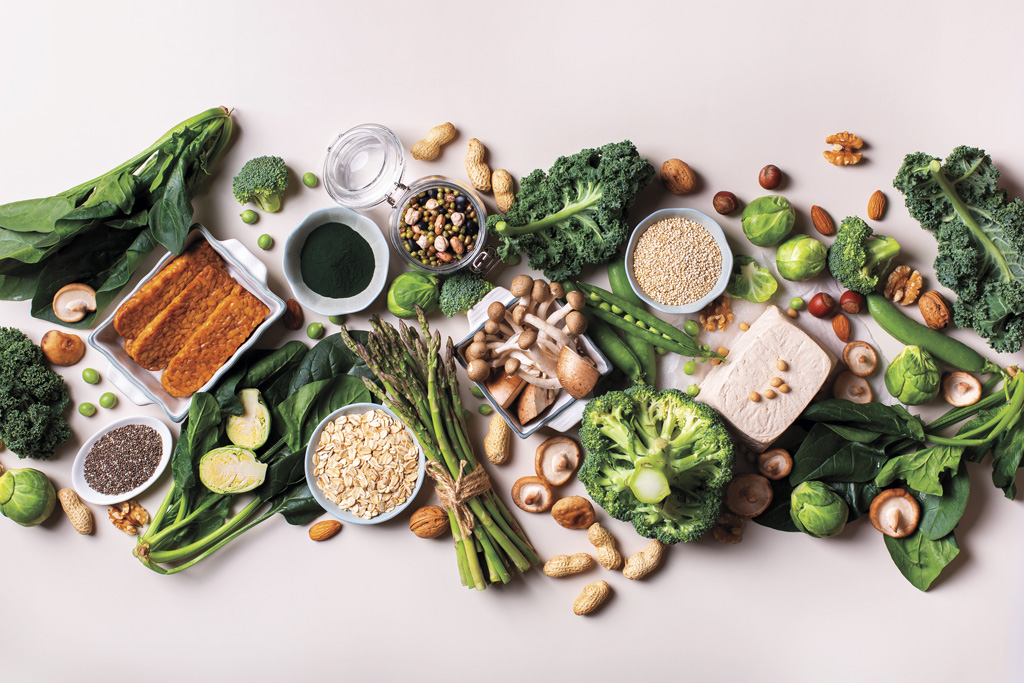Recipes
Dr. Linda Shiue’s Cookbook Proves That Healthy Eating Can Be Delicious
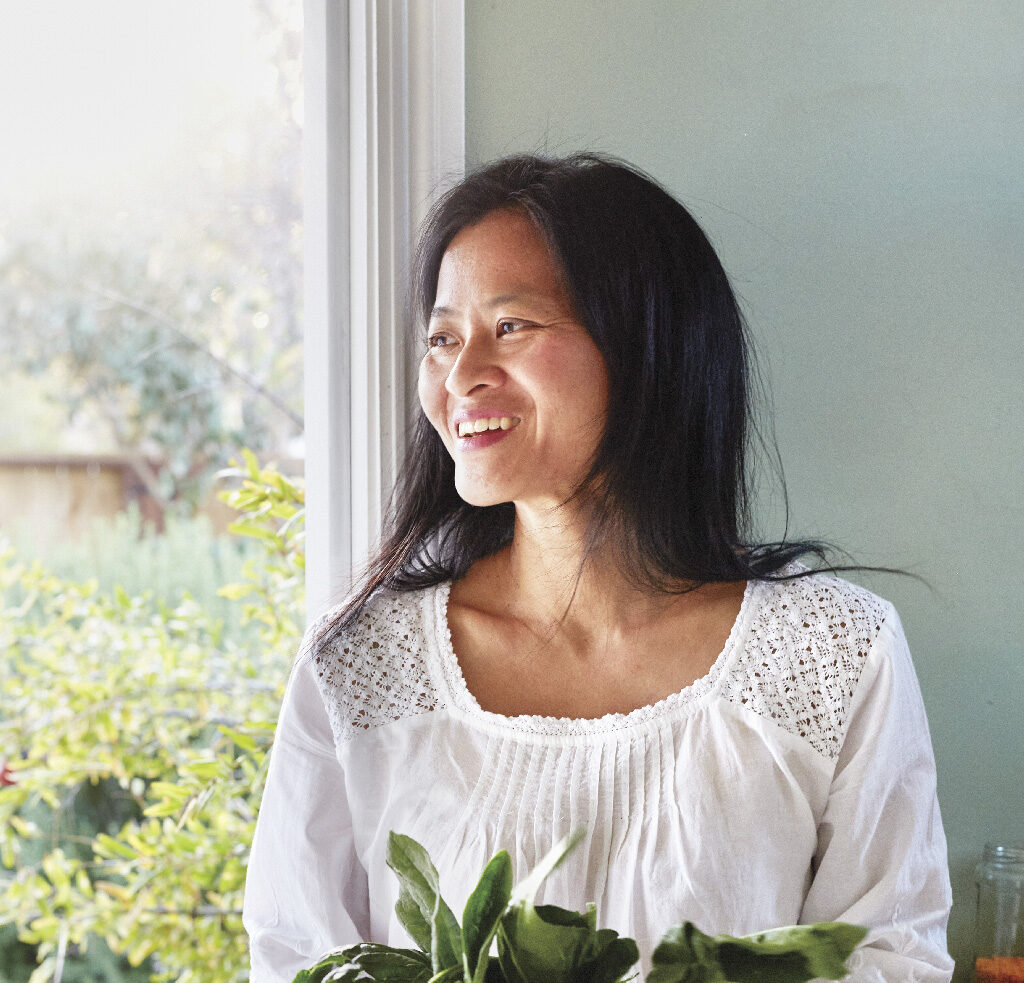 Portrait of Dr. Linda Shiue courtesy of Hachette Go
Portrait of Dr. Linda Shiue courtesy of Hachette GoAs we head into a change of season it’s all about finding new ways to stay healthy. Sure, an apple a day might keep the doctor away — but apples every day? Boooring. Thanks to San Francisco culinary medicine physician Dr. Linda Shiue, MD’s, cookbook, Spicebox Kitchen: Eat Well and Be Healthy with Globally Inspired, Vegetable-Forward Recipes (Hachette Go), boring is not on the menu.
In page after colorful page of globally inspired, vegetable-forward recipes flavored by powerfully healing herbs and potent spices that feel like a passport to the world, Shiue takes readers on an exciting journey to eating well.
Shiue herself is anything but dull. Her career accomplishments read like a bucket list. She knew she wanted to be a doctor when she was in kindergarten and took her first French cooking class at 7 years old. As if graduating from Brown University and working as a practicing internal medicine doctor in the Bay Area for more than two decades weren’t enough, she took a year off to attend cooking school and then found time to work in the San Francisco Michelin-starred kitchen Mourad.
Shiue says of her unconventional path, “Food was there as my hobby and personal passion.” But she never thought it would become a part of her career until she attended a medical education conference in Napa at the Culinary Institute of America at Copia called “Healthy Kitchens, Healthy Lives.”
“And that was it,” she remembers. “I literally thought ‘this is what I need to do.’ ” She taught her first class the very next week.
At the time she was working at a medical foundation and started teaching on the side wherever people would have her. She eventually started a healthy cooking program for patients at a medical center in San Francisco.
Those early classes focused on subjects like low-sodium cooking for people with hypertension. She has since created classes for survivors of cancer and stroke and those struggling with IBS. And she’s always being asked to cover more topics.
Shiue believes the best medicine is prevention, and her recipes and classes showcase seasonal produce, accented with health-promoting spices and fresh herbs.
Spicebox Kitchen cookbook was born out of a desire to share her knowledge with more people, like those who might not be able to take one of her classes.
As Shiue explains it, no medical technology will make a person feel better in terms of wellness. “No drug can do that. It’s how you take care of yourself that will make you feel better immediately.”
“That’s powerful,” she says. “And it puts that power back into a patient’s hands.”
Good Health Starts in the Kitchen
These physician-created recipes are fun, delicious and just what the body ordered.
Excerpted from SPICEBOX KITCHEN: Eat Well and Be Healthy with Globally Inspired, Vegetable-Forward Recipes by Linda Shiue, MD (Hachette Go).
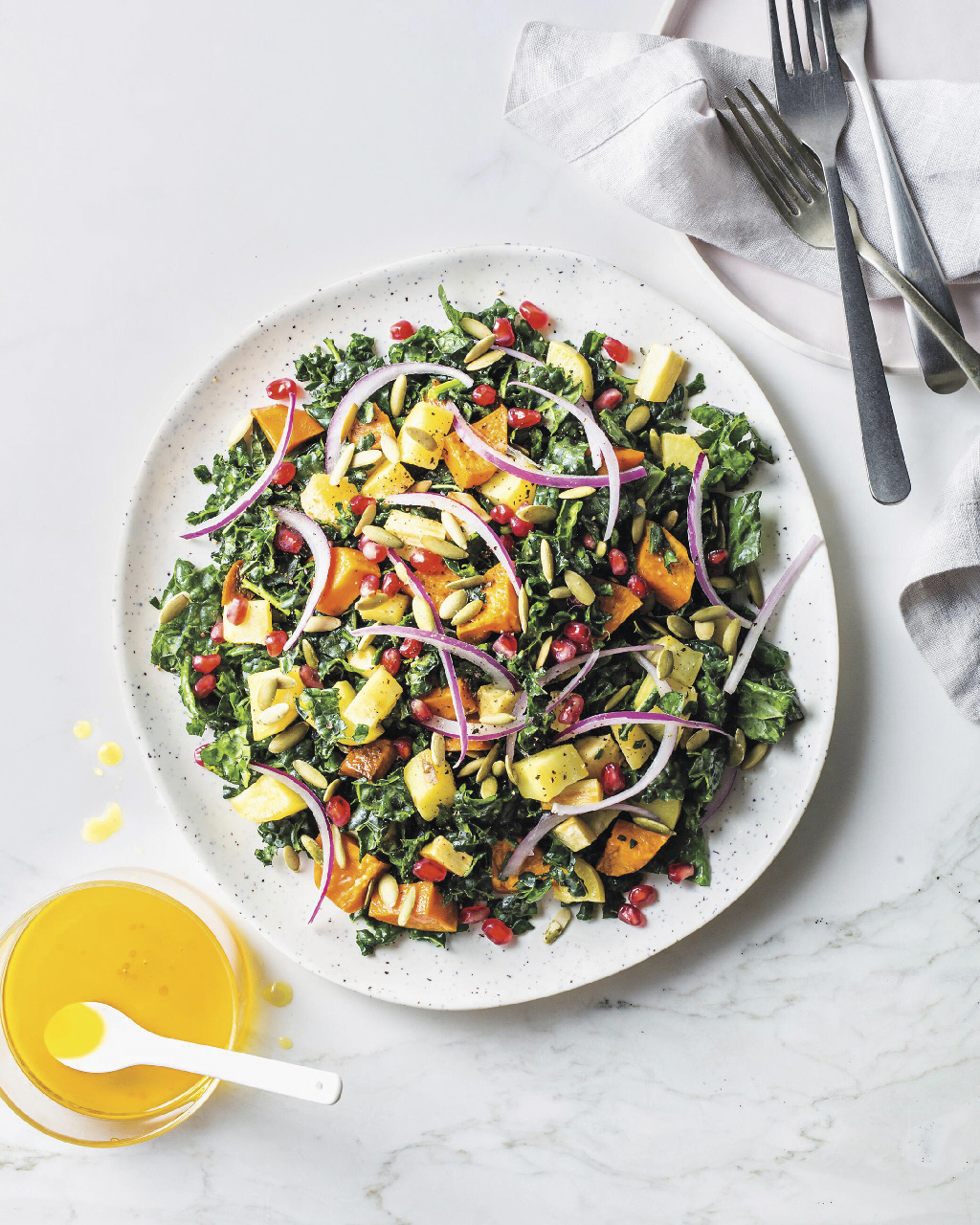
Thanksgiving Kale Salad With Roasted Root Vegetables
Serves 12
Yes, even on Thanksgiving, I serve my family and friends kale salad. This is a vibrant and robust taste of fall, full of hearty, seasonal root vegetables, a hint of maple syrup and the crunch of pumpkin seeds. You’ll “eat the rainbow” when you eat this salad, which is hearty enough to make a meal for your vegetarian guests with a side of quinoa or farro.
INGREDIENTS
- 1½ pounds of assorted root vegetables, such as sweet potato, delicata squash, and parsnip (about 2 small potatoes, 1 delicata, 1 parsnip)
- 2 tablespoons of olive oil
- pinch of salt
- 1 bunch curly green kale, center rib removed
DRESSING
- 1 tablespoon pure
maple syrup - 2 tablespoons apple
cider vinegar - 2 tablespoons
extra-virgin olive oil - Pinch of salt
- freshly ground
black pepper
GARNISHES
- ¼ cup raw hulled pumpkin seeds (pepitas)
- ¼ cup pomegranate arils
- 2 tablespoons thinly sliced red onion
Instructions
- Heat oven to 400°F. Line two baking sheets with parchment paper. Peel root vegetables, as desired (no need to peel delicata), and then cut into 1/4- to 1/2-inch-thick slices. Toss with olive oil and salt in a bowl, then arrange in a single layer, with some space between vegetables, on prepared baking sheets. Cook until tender, about 20 minutes, flipping over at 10-minute point. When vegetables are light brown around edges and you’re able to pierce them with a fork, remove from oven and allow to cool.
- Thinly slice or tear kale into bite-size pieces and place in a salad bowl. Massage kale with your hands for about a minute, or until it has softened and is glossy and darker green.
- Prepare dressing Combine all dressing ingredients in a small bowl and whisk, or pour into a jar, tightly close lid and shake until combined. Pour dressing onto prepared kale and toss to cover.
- Toast pumpkin seeds for garnish Place in a single layer in a small, dry skillet and heat over medium-low heat, shaking often, until pumpkin seeds puff up a bit and change from green to tan. This will take 30 to 60 seconds. Remove from heat and allow to cool.
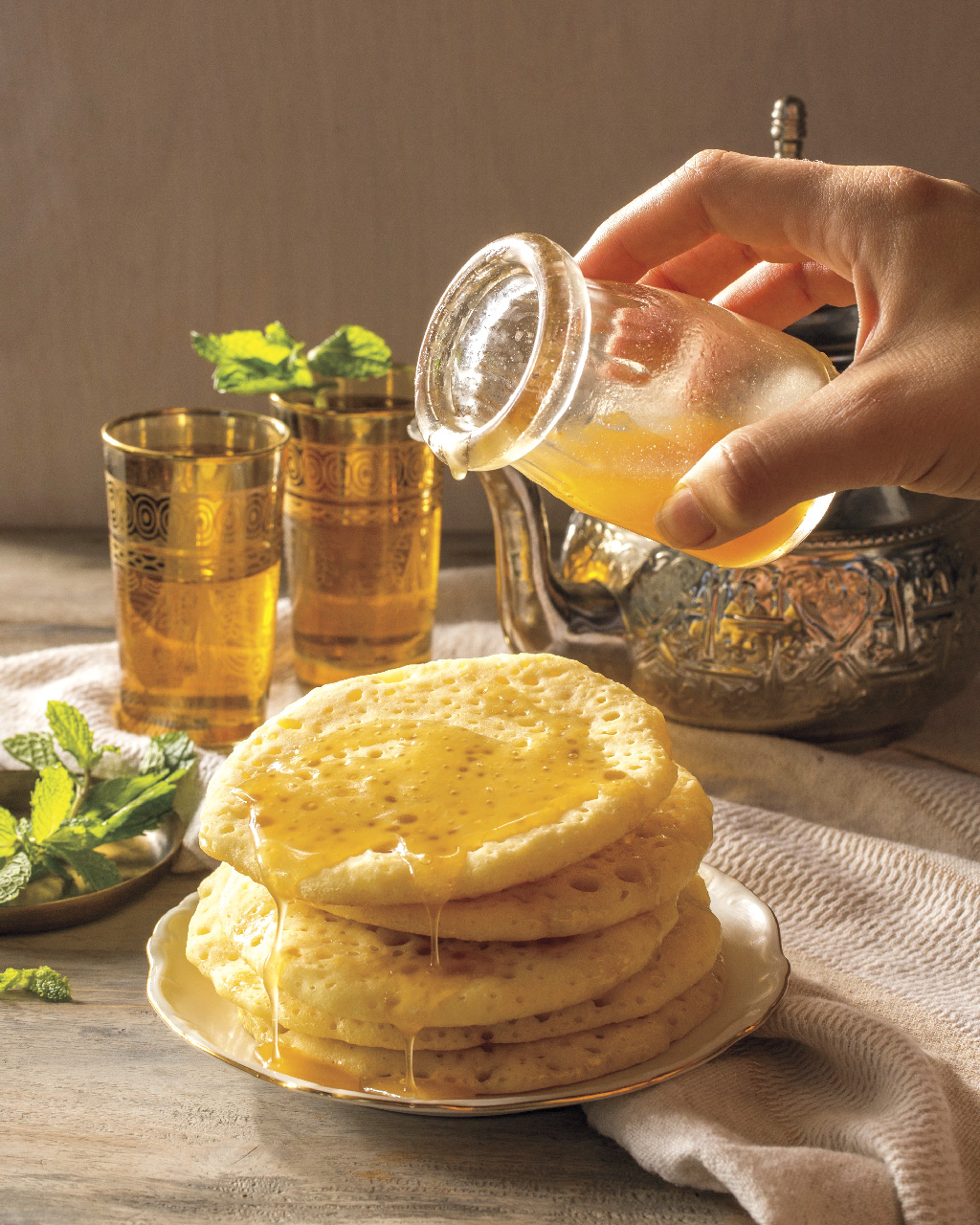
Baghrir With Orange Flower Water Honey Syrup
Makes 15 crepes
One of the special items at our Moroccan breakfasts were these crepes (baghrir), which are typically served with butter and honey. They are made with semolina (ground durum wheat), which brings a slight, pleasant crunchiness to the batter, and because they are yeasted, they have many tiny holes that soak up whatever you top them with. To bring in one of my favorite sweet flavors from Morocco, I combined these elements with orange flower water in a syrup. This seems slightly decadent as a breakfast and wouldn’t be wrong as dessert.
INGREDIENTS
- 1½ cups semolina
- ¼ cup all-purpose flour
- 1½ teaspoons instant yeast
- ½ teaspoon salt
- 2 cups warm water, about 110°F
- 1 tablespoon baking powder
- unsalted butter, for pan
Instructions
- Place all ingredients, except butter, in a blender and blend until smooth, about 1 minute. Keep covered and allow to rest for 30 minutes.
- After resting, blend batter for another second before cooking.
- Heat an 8-inch nonstick, lightly buttered skillet (use an omelet pan, if you have one) over medium-low heat. Pour ¼ cup of batter into pan — it should spread immediately into a circle almost fitting the diameter of the pan. Cook until the surface is covered in holes, about 30 seconds. Cook only one side. Err on the side of underdone — if the sides start to curl up, you’ve overcooked the baghrir and it will be tough. Its underside should be at most lightly golden. Keep warm on a plate covered with a clean, dry towel until ready to serve. Repeat with remaining batter.
- Serve hot with butter and honey or jam, or Orange Flower Water Honey Syrup (recipe at left).
Orange Flower Water
Honey Syrup
Makes about 1 1/2 cups syrup
INGREDIENTS
- 8 tablespoons (1 stick) unsalted butter (substitute Miyoko’s Vegan Butter to
make vegan) - ¾ cup honey
- ½ to 1 teaspoon kosher salt
- 2 to 4 teaspoons orange flower water, to taste
Instructions
- Melt together first three ingredients in a small saucepan over low heat and whisk until smooth.
- Stir in orange flower water and serve warm.
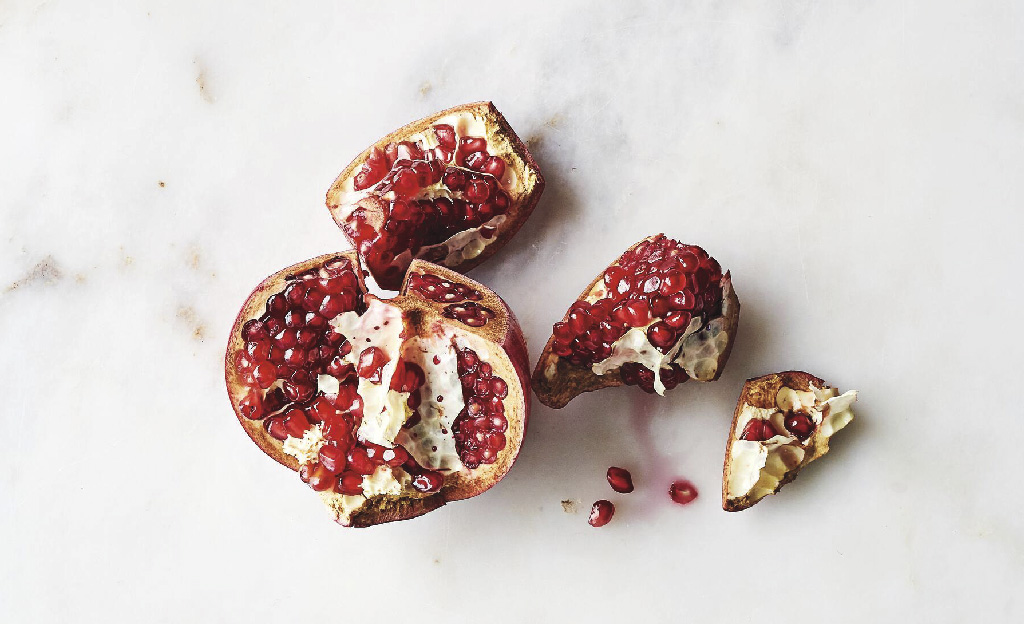
Muhammara
Makes 2 cups dip
first came upon a recipe for muhammara when I was asked to bring three dips to a Thanksgiving potluck. I remember wanting to impress, as my hosts were sophisticated cooks who also happened to have published several cookbooks. (No pressure there!) Although I had never had muhammara before, when I saw the recipe for it, I knew it would be a winner. With its base of red peppers, muhammara gets its creaminess from walnuts, and a little bit of sweetness and tanginess from pomegranate molasses (if you can’t find it store-bought, the book includes pointers for making your own).
INGREDIENTS
- 2 red bell peppers, or 1 (7-ounce) jar roasted red peppers, drained
- 1 cup of walnuts
- 3 garlic cloves, minced
- juice of 1 lemon
- 2 tablespoons pomegranate molasses
- 1 teaspoon ground cumin
- 1 teaspoon red pepper flakes
- 2 tablespoons extra-virgin olive oil
- salt
Instructions
- Roast bell peppers, if using fresh Preheat oven to 450°F. Place whole bell peppers in a baking dish and bake for about 30 minutes, rotating once or twice for evenness, until their skin has blackened and peppers are soft to touch. Remove from oven and put right away into a small resealable plastic bag and seal tightly. Let rest for about 5 minutes, then remove from bag and quickly peel off skin (be careful, peppers will still be quite hot). Remove seeds, then cut peppers into long strips and set aside until ready to use.
- Toast walnuts Preheat oven to 350°F. Spread walnuts on a baking sheet and toast in oven for 10 to 15 minutes or until golden and aromatic. Alternatively, toast in a dry skillet over low heat.
- Combine roasted peppers, walnuts, garlic, lemon juice, pomegranate molasses, cumin and red pepper flakes in a food processor and process until mixture is smooth. Then with motor running, add oil gradually so it can emulsify rather than separate. Transfer muhammara to a bowl and add salt to taste. Serve at room temperature with pita.






